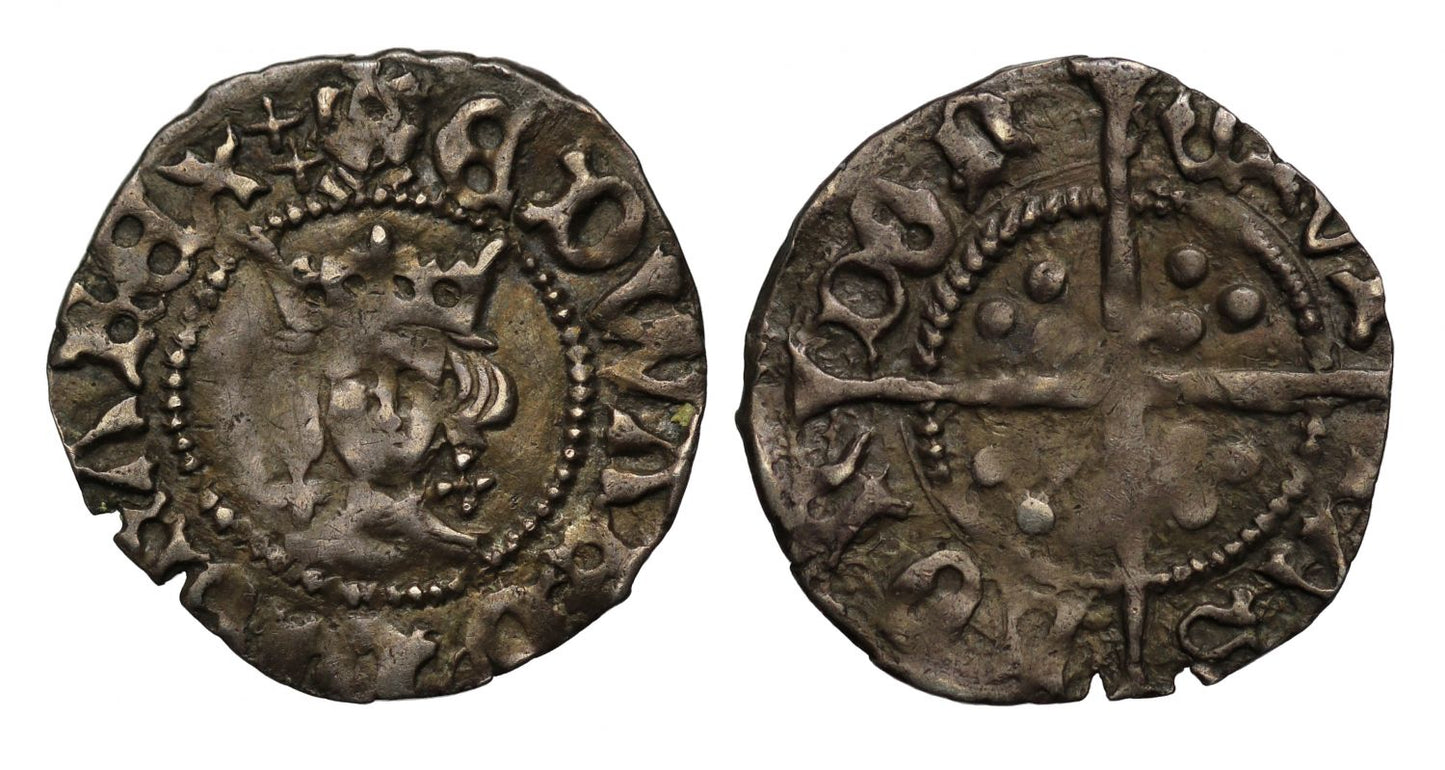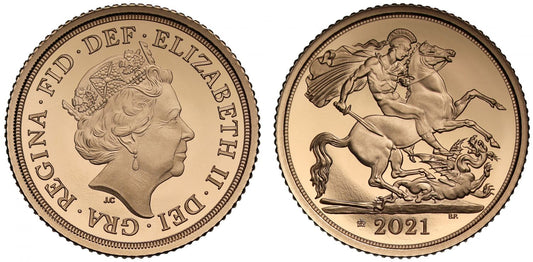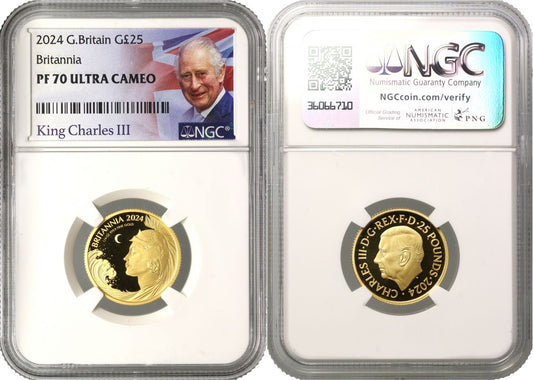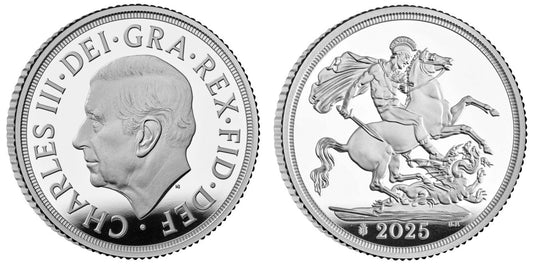FAQs
What makes a coin valuable?
I have coins to sell, what’s the next step?
How will my purchases be shipped?
What happens if I’m not entirely happy with my purchase?
Edward IV Halfpenny, Heavy coinage, London Mint, class II, quatrefoils at neck
Edward IV, first reign (1461-70), silver long cross Halfpenny, heavy coinage (1461-64), class II, London Mint, facing crowned bust, quatrefoil either side of neck, Latin legend and beaded borders surrounding both sides, initial mark rose, *EDWARDx DI GRA REXxx, rev. long cross pattee, trio of pellets in each angle, CIVI TAS LOn DOn, weight 0.44g (Withers 4n; N.1546; S.1990). Toned weak in parts, very fine with a great provenance.
The abbreviated Latin legends translate as on the obverse "Edward, by the Grace of God, King" and on the reverse "City of London."
Born on the 28th April 1442 in Rouen, the son of Richard Plantagenet the third Duke of York, Edward inherited the Yorkist claim on the death of his Father at the Battle of Wakefield in December 1460. After then defeating Lancastrian forces at the Battle of Towton on 29th March 1461 in a snowstorm, he deposed King Henry VI imprisoning him in the Tower of London. Edward went on to marry Elizabeth Woodville on 1st May 1464 with whom he had seven daughters and three sons, seven of which survived him, though the two surviving sons later became known as the tragic "Princes in the Tower".
Firstly, though the marriage of Edward to Elizabeth enraged the Earl of Warwick, as Elizabeth was a widow of Lancastrian John Grey of Groby killed at Towton and had had two sons with him. Later Edward dismissed his Lord Chancellor in 1467 George Neville the Archbishop of York, who was Warwick's brother causing Warwick to form an alliance against Edward with the latter's younger brother the Duke of Clarence, who owned neighbouring estates to Warwick. King Edward then blocked a marriage proposal between Clarence and Warwick's eldest daughter Isabel, but the marriage went ahead and took place in Calais, France presided over by George Neville. The three men then issued a "remonstrance" of alleged abuses by the Woodvilles and other advisors of Edward, returned to London and raised an army which went on to defeat the Royal army at Edgecote Moor on 24th July 1469 with Edward then being held at Middleham Castle. On the 12th August Edward's Father in law Richard Woodville and his youngest son John were executed at Kenilworth Castle, but subsequent support for the actions of Warwick and Neville were low and Edward was released in September to resume rule. Edward went on to reinstate Henry Percy as Earl of Northumberland, who had previously fought for Lancaster giving back his estates that had been presented to John Neville, Warwick's brother with Neville in turn being given the title Marquess of Montague as compensation. By March of 1470 Warwick and Clarence escalated a more private feud into a full scale revolt, but were defeated fleeing to France by May of that year. Louis XI encouraged Warwick to negotiate an alliance with Queen Margaret, and with French support they landed in England on 9th September 1470 to restore King Henry. An army of 30,000 was formed as Yorkist support in England was low. Edward narrowly escaped capture to Bruges and Henry was restored. Edward received little support from his brother in law Charles the Bold, but by March 1471 backed by Flemish merchants he landed near Hull close to his Yorkshire estates, and persuading the City of York to open its gates to him. He marched south gaining more support along the way entering London unchallenged and taking Henry prisoner. Warwick was defeated and killed at the Battle of Barnet on 14th April 1471, and Edward Westminster the son of Henry, was killed at the Battle of Tewkesbury on 4th May 1471, with the imprisoned Henry dying shortly after. Edward's second period of rule began, and he had only to quell one significant rebellion in February 1474 by John de Vere the 13th Earl of Oxford, who survived to be in command of the Lancastrian army at Bosworth field nine years later. The Duke of Clarence was alleged to have been involved in the rebellion leading to his execution at the Tower on 18th February 1478. In 1475 Edward allied with Burgundy to declare war on France and Louis opened negotiations with Edward, landing at Calais and signing the Treaty of Picquigny giving a payment of 75,000 crowns to Edward and a pension of 50,000 more a year which helped recoup costs of his army. In 1482 Edward backed an attempt by Alexander Stewart to usurp the Scottish throne from James III which led to withdrawal, only capturing Berwick Castle. Edward fell fatally ill at Easter 1483 and survived long enough to add codicils to his will placing his brother Richard as Protector of his son Edward. Edward IV died on the 9th April 1483.
Capital City London upon the River Thames following Roman occupation, minted some of the earliest Saxon coins with gold Thrymsas and silver denarii with a "Londuniu" signature. Mercian Kings beginning with Offa minted coins there, but the first coin to actually say City of London upon it is the unique Ludica portrait Penny that was found in 2016, followed by subsequent coins of Ecgberht. In 871 the Danes wintered in London for the first time but was King Alfred of Wessex who settled and fortified the capital circa 880 to resist further invasions. Edward the Elder incorporated the City in Wessex in 911 and it resisted a major attack in the reign of Aethelred II in 1009. However, London submitted to the Danish Swein in 1013, but three years later the citizens accepted Eadmund Ironside as King and resisted a siege by Canute.
Later unsettled times occurred in the anarchy period of the reign of King Stephen, remaining loyal to the King except for a few months in 1141 when Empress Matilda was admitted but within a short time expelled. Coinage activity here has been mostly constant throughout history from the Romans until the reign of our current Queen and only moving out to Wales from 1969.
Provenance:
Ex F. W. Longbottom, Sotheby, 14th May 1934, lot 193 part, illustrated on plate II.
Ex Lord Grantley, fourth portion, Sotheby, 20th April 1944, lot 1431 part.
Ex Richard Cyril Lockett, English part V, Glendining, lot 3137
Ex Mrs M. Delme Radcliffe, Glendining, 17th April 1985, lot 174.
Ex Spink and Son Ltd, London, purchased August 2001,
Ex Mark E. Freehill Collection, Noble Numismatics, Auction 122, 19-21st November 2019, lot 2844.
Ex Collection of an English Doctor part III, Sovereign Rarities fixed price list online September 2022.
FAQs
What makes a coin valuable?
I have coins to sell, what’s the next step?
How will my purchases be shipped?
What happens if I’m not entirely happy with my purchase?













